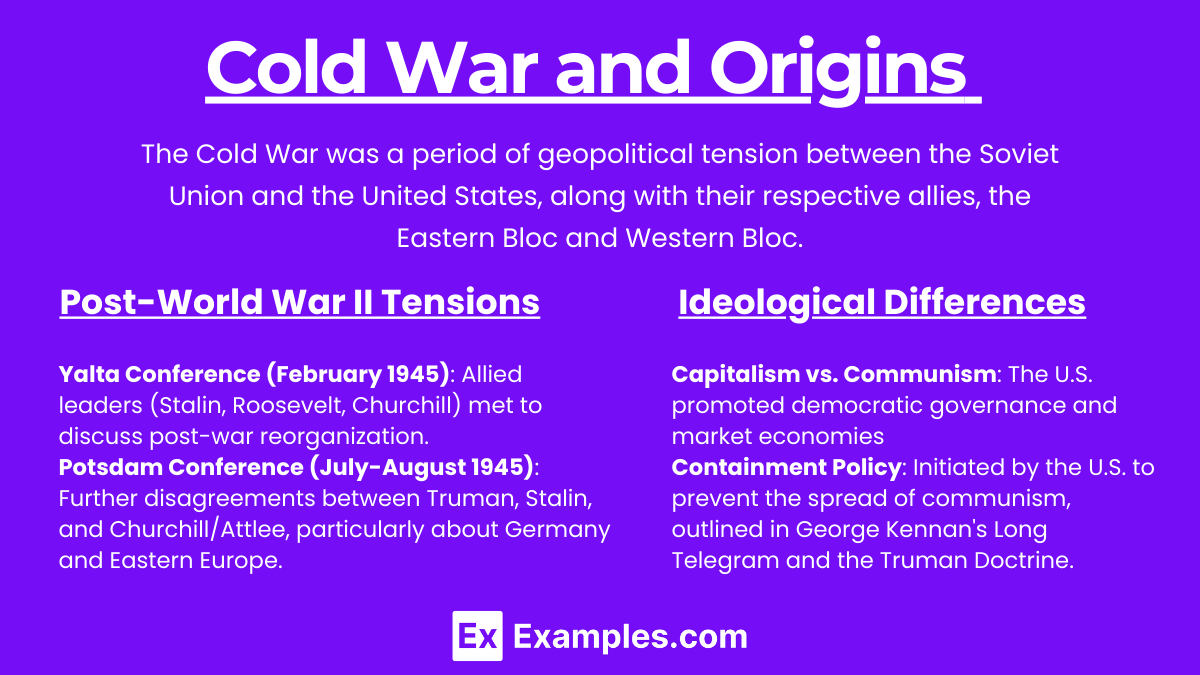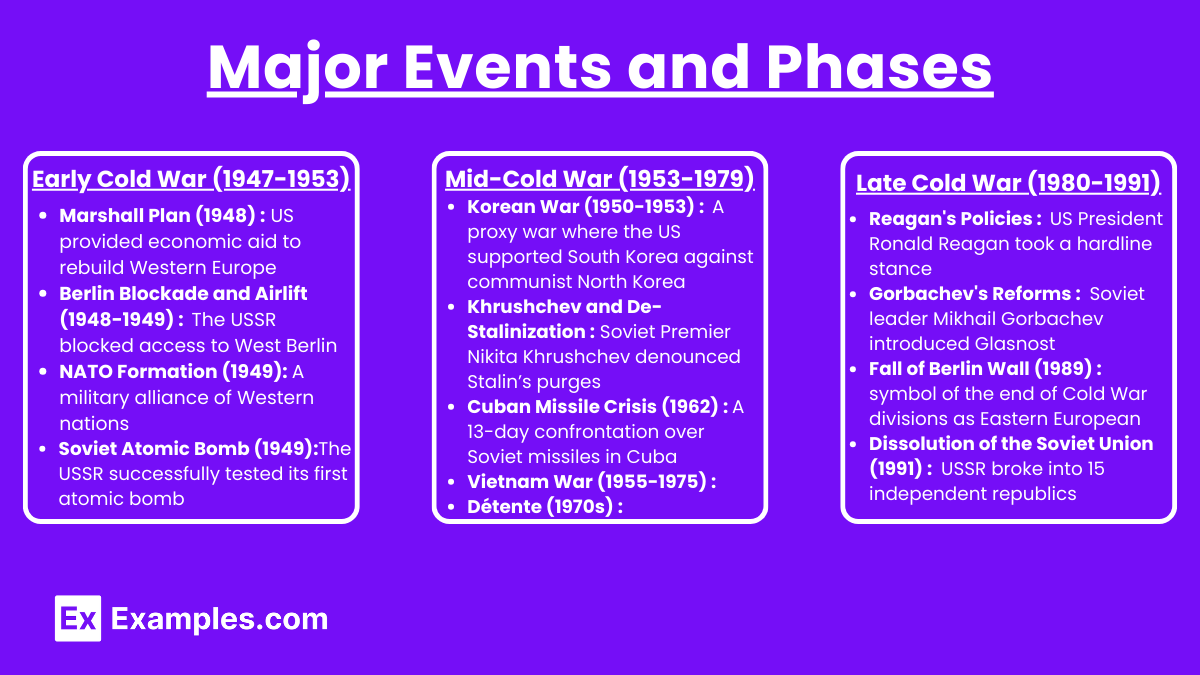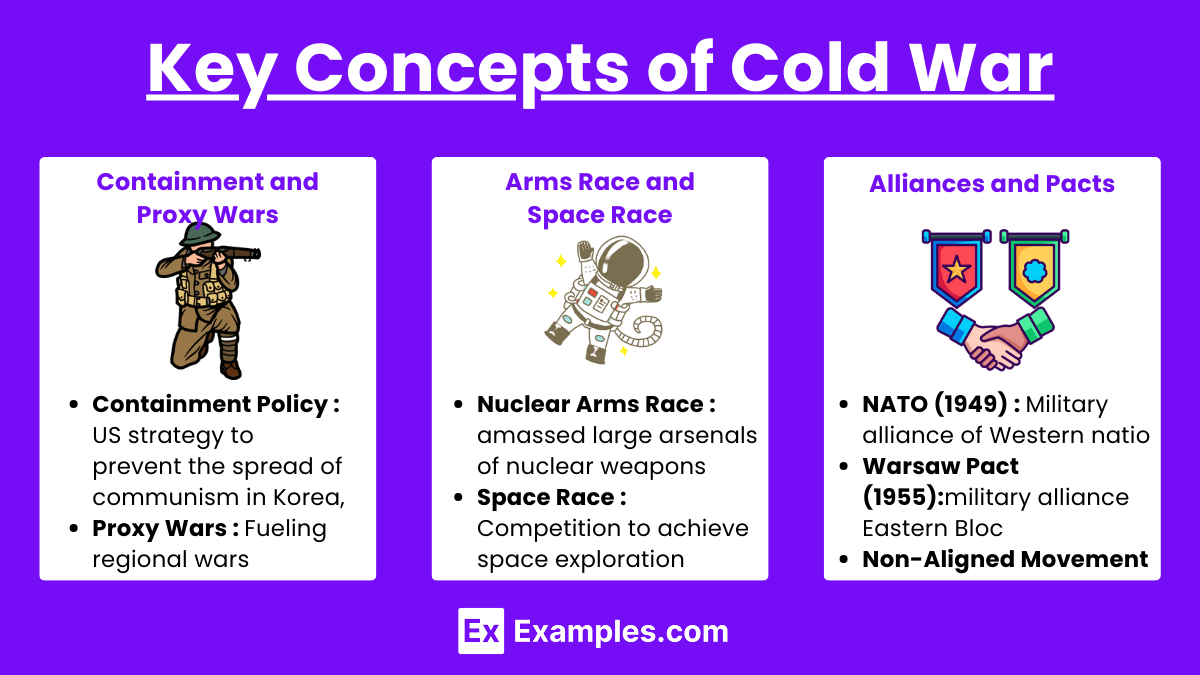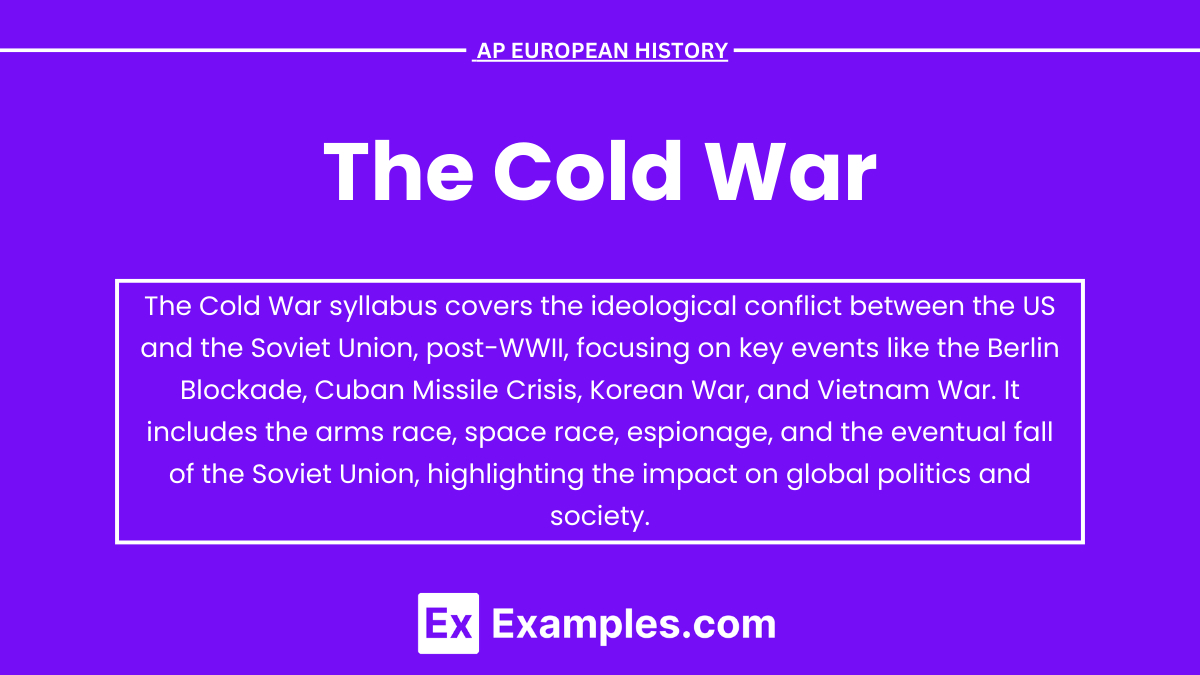The Cold War, a period of geopolitical tension between the Soviet Union and the United States, lasted from 1945 to 1991. This era, significant for AP European History, saw intense rivalry marked by ideological, political, military, and economic conflicts. Despite the absence of direct warfare, the superpowers engaged in proxy wars, nuclear arms races, and various forms of indirect confrontation. Understanding the Cold War is crucial for comprehending the post-World War II international landscape and the development of modern Europe.
Learning Objectives
By studying "The Cold War," you should understand the origins and causes of post-World War II tensions between the United States and the Soviet Union, and the ideological differences of capitalism and communism. Analyze key events, such as the Berlin Blockade, Cuban Missile Crisis, and the fall of the Berlin Wall. Evaluate the impact of major figures, including Truman, Kennedy, Khrushchev, and Gorbachev. Understand the Cold War’s global influence, proxy wars, and its lasting impact on international relations and European history.
Cold War and Origins

The Cold War was a period of geopolitical tension between the Soviet Union and the United States, along with their respective allies, the Eastern Bloc and Western Bloc. It lasted from the end of World War II in 1945 until the dissolution of the Soviet Union in 1991. This era was marked by ideological, political, military, and economic rivalry, but it did not result in direct warfare between the superpowers.
Origins of the Cold War
Post-World War II Tensions
Yalta Conference (February 1945): Allied leaders (Stalin, Roosevelt, Churchill) met to discuss post-war reorganization. Differences emerged over Eastern Europe's future.
Potsdam Conference (July-August 1945): Further disagreements between Truman, Stalin, and Churchill/Attlee, particularly about Germany and Eastern Europe.
Ideological Differences
Capitalism vs. Communism: The U.S. promoted democratic governance and market economies, while the Soviet Union supported communist dictatorships and planned economies.
Containment Policy: Initiated by the U.S. to prevent the spread of communism, outlined in George Kennan's Long Telegram and the Truman Doctrine.
Major Events and Phases

Early Cold War (1947-1953)
Marshall Plan (1948): US provided economic aid to rebuild Western Europe, countering Soviet influence.
Berlin Blockade and Airlift (1948-1949): The USSR blocked access to West Berlin; the US and its allies supplied the city via air.
NATO Formation (1949): A military alliance of Western nations to counter Soviet threats.
Soviet Atomic Bomb (1949): The USSR successfully tested its first atomic bomb, ending US nuclear monopoly.
Mid-Cold War (1953-1979)
Korean War (1950-1953): A proxy war where the US supported South Korea against communist North Korea, backed by China and the USSR.
Khrushchev and De-Stalinization: Soviet Premier Nikita Khrushchev denounced Stalin’s purges and sought peaceful coexistence, though tensions persisted.
Cuban Missile Crisis (1962): A 13-day confrontation over Soviet missiles in Cuba, bringing the world close to nuclear war.
Vietnam War (1955-1975): The US fought to prevent the spread of communism in Southeast Asia, resulting in a costly and divisive conflict.
Détente (1970s): A period of relaxed tensions and improved relations, marked by arms control agreements like SALT I (1972).
Late Cold War (1980-1991)
Reagan's Policies: US President Ronald Reagan took a hardline stance against the USSR, initiating a significant military buildup and the Strategic Defense Initiative (SDI).
Gorbachev's Reforms: Soviet leader Mikhail Gorbachev introduced Glasnost (openness) and Perestroika (restructuring) to address economic stagnation and political corruption.
Fall of Berlin Wall (1989): A symbol of the end of Cold War divisions as Eastern European countries began rejecting communism.
Dissolution of the Soviet Union (1991): The USSR broke into 15 independent republics, effectively ending the Cold War.
Key Concepts of Cold War

Containment and Proxy Wars
Containment Policy: The US strategy to prevent the spread of communism, influencing its involvement in Korea, Vietnam, and other regions.
Proxy Wars: Indirect conflicts where superpowers supported opposing sides, avoiding direct confrontation but fueling regional wars.
Arms Race and Space Race
Nuclear Arms Race: Both superpowers amassed large arsenals of nuclear weapons, leading to the concept of Mutually Assured Destruction (MAD).
Space Race: Competition to achieve space exploration milestones, highlighted by the Soviet launch of Sputnik (1957) and the US Apollo moon landing (1969).
Alliances and Pacts
NATO (1949): Military alliance of Western nations.
Warsaw Pact (1955): Soviet-led military alliance of Eastern Bloc countries.
Non-Aligned Movement: Countries that did not formally align with either superpower, seeking to remain independent.
Impact and Legacy
Political and Social Impact
Europe: Division of Germany and the eventual reunification in 1990; Eastern Europe’s transition from communism to democracy.
Global: Shifts in geopolitical alliances, decolonization, and the emergence of the Third World as a political force.
Domestic: Anti-communist sentiment in the US (e.g., McCarthyism) and economic stagnation in the USSR.
Technological and Cultural Impact
Technological Advancements: Innovations driven by military needs and space exploration.
Cultural Exchange: Propaganda, espionage, and cultural diplomacy influenced public perception and international relations.
The Cold War shaped much of the 20th century, influencing international relations, political ideologies, and economic policies. Understanding its origins, key events, and lasting impact is crucial for comprehending contemporary global dynamics.
Examples
Example 1 : The Berlin Blockade and Airlift (1948-1949)
The Soviet Union blocked all ground routes into West Berlin, attempting to force the Allies out of the city. In response, the United States and its allies organized the Berlin Airlift, supplying West Berlin with food and fuel through continuous air transport.
Example 2 : The Cuban Missile Crisis (1962)
A 13-day confrontation between the United States and the Soviet Union over Soviet ballistic missiles deployed in Cuba. The crisis ended with an agreement for the Soviets to dismantle the missiles in exchange for the U.S. promising not to invade Cuba and secretly removing U.S. missiles from Turkey.
Example 3 : The Korean War (1950-1953)
A conflict between North Korea, supported by China and the Soviet Union, and South Korea, backed by the United States and other Western nations. The war ended in an armistice, with Korea remaining divided at the 38th parallel.
Example 4 : The Vietnam War (1955-1975)
A prolonged conflict between communist forces in North Vietnam, supported by China and the Soviet Union, and South Vietnam, backed by the United States. The war ended with the fall of Saigon and the unification of Vietnam under communist control.
Example 5 : The Space Race (1957-1969)
A competition between the United States and the Soviet Union to achieve significant milestones in space exploration. Key events include the Soviet Union launching the first artificial satellite, Sputnik, in 1957, and the United States landing the first humans on the moon with Apollo 11 in 1969.
Multiple Choice Questions
Question 1:
What was the primary purpose of the Truman Doctrine?
a) To support European economic recovery after World War II
b) To provide military aid to South American countries
c) To contain the spread of communism
d) To promote free trade across the Atlantic
Answer: c) To contain the spread of communism
Explanation: The Truman Doctrine, announced by President Harry S. Truman in 1947, aimed to provide political, military, and economic assistance to democratic nations under threat from authoritarian forces, primarily focusing on containing the spread of communism. It marked the beginning of the U.S. policy of containment, which sought to prevent the expansion of Soviet influence during the Cold War.
Question 2:
Which event is commonly considered the beginning of the Cold War?
a) The signing of the North Atlantic Treaty
b) The Berlin Blockade
c) The Cuban Missile Crisis
d) The Yalta Conference
Answer: b) The Berlin Blockade
Explanation: The Berlin Blockade (1948-1949) is often considered the first major crisis of the Cold War. The Soviet Union blocked all ground routes into West Berlin, attempting to force the Western Allies to abandon the city. In response, the Allies organized the Berlin Airlift to supply the city, demonstrating their commitment to containing Soviet expansion. This event significantly heightened tensions between the East and West and solidified the division of Berlin and Germany.
Question 3:
Which doctrine was established to justify U.S. intervention in Latin America during the Cold War?
a) The Monroe Doctrine
b) The Marshall Plan
c) The Eisenhower Doctrine
d) The Reagan Doctrine
Answer: d) The Reagan Doctrine
Explanation: The Reagan Doctrine, articulated during the presidency of Ronald Reagan in the 1980s, aimed to provide overt and covert support to anti-communist resistance movements in Africa, Asia, and Latin America. The doctrine was a significant aspect of Reagan's strategy to roll back the influence of the Soviet Union by supporting guerrilla forces fighting communist governments or movements. The doctrine underscored the U.S. commitment to countering Soviet influence globally, especially in regions outside of Europe.


